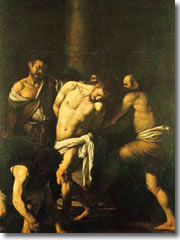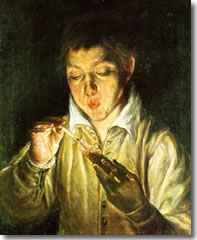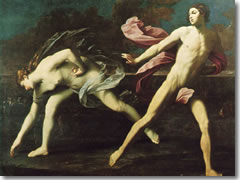
Caravaggio's Flagellation in the Museo CapodimonteSet in an 18th-century royal palace in the midst of shady, grassy Capodimonte park high above the city, this is by far the best painting gallery in all of Southern Italy, particularly strong in works from Old Masters representing all phases of the Renaissance and baroque periods.
The layout is often being rearranged as the gallery integrates the original core Farnese collections with various canvases that belong to churches and other collections around town but were sent here for safe keeping.
Among the early Renaissance paintings are fine works by Masolino, Masaccio (his Crucifixion of 1426 is simple yet haunting), a young Botticelli, Filippino Lippi, and Andrea Mantegna.
Giovanni Bellini's Transfiguration (1478–79) is one of his—and the museums—masterpieces.
From the great Raphael we have Portrait of Cardinal Alessandro Farnese (who'll soon become Pope Paul III; 1511), a cartoon of Moses and the Burning Bush (1514), and an Eternal Father.
Representing the genius of Michelangelo is a cartoon of soldiers that he made as a study for his Crucifixion of St. Peter fresco in the Vatican.
There are High Renaissance pieces from Sebastiano del Piombo and Correggio, whose 1518 Marriage of St. Catherine is a finely studied classical work.
Titian painted a whole gaggle of portraits of various Farnese cardinals in the 1540s, along with a provocative Danäe (1546) painted for Cardinal Alessandro Farnese (and probably using the cardinal's mistress as the goddess model), and the Portrait of a Young Lady (1546), which some scholars believe is actually a portrait of Titian's own daughter.

El Greco's Youth Lighting a Candle in the Museo CapodimonteEl Greco contributes a Healing of the Blind, Portrait of Giulio Clovio (1572), and the haunting El Soplón, or Youth Lighting a Candle with a Coal (1575). There are many good Mannerist works from the brushes of Andrea del Sarto, Pontormo, Rosso Fiorentino, and Parmigianino.
After a breather of Flemish paintings—look especially for The Misanthrope and The Blind Leading the Blind, both 1568 works by Peter Bruegel—the baroque proper is rung in with a survey of the Carracci clan, including works by Agostino, Ludovico, and especially Annibale Carracci, who pokes fun at his arch-competitor Caravaggio by painting that artist's leering face on his rendition of a Satyr.
Caravaggio got the last laugh, though, since art history books give but a paragraph to Carracci while filling pages with homage to Caravaggio's genius for composition and dramatic use of chiaroscuro (strongly contrasting light and dark areas), well evident in the excellent Flagellation of Christ (1609) kept here.

Guido Reni's Atalanta and Ippomene in the Museo Capodimonte.Calabrian Mattia Preti painted his 1657 San Sebastiano in a Caravaggesque style, as did Spaniard Giuseppe Ribera in his Drunken Silenus. Another Caravaggesque master—and the early baroque's greatest (and virtually only) female artist—was Artemisia Gentileschi, whose rape as a teenager (and the subsequent highly public and sensational trial) may have later led her to turn her artistic lens often to the many examples throughout history, myth, and the Bible wherein women exact revenge upon men, as in this gallery's gory Judith Beheading Holofernes.
Luca Giordano manages to give good compositional balance and use of light to baroque extravagance in his Madonna del Baldacchino (1686). Giordano's Neapolitan colleagues fill rooms up on the first floor, bringing the museum's survey through the 19th century to a small collection of contemporary art.
Taking a break from painting, pop into the small, excruciatingly elaborate Chinese-style Salottino di Porcellana for an excellent example of Italy's finest 18th-century porcelain, still being produced in a nearby factory (built in 1743) here on Capodimonte.Parco di Capodimonte, Via Capodimonte
tel. +39-081-749-9111
www.polomusealenapoli.beniculturali.it
or
www.coopculture.it
Thurs–Tues 8:30am–7:30pm
€12
Bus: C63, R4, 178, M2, 201
Hop-on/hop-off: Capodimonte, Catacomb S. Gennaro (A)
Planning your day:Expect to spend at least 90 minutes here. Two hours or more is more likely. (Don't forget to budget at least 10–15 minutes each way just to get out here, as the museum is not really near anything.)
Share this page
Search ReidsItaly.com
Parco di Capodimonte, Via Capodimonte
tel. +39-081-749-9111
www.polomusealenapoli.beniculturali.it
or
www.coopculture.it
Thurs–Tues 8:30am–7:30pm
€12
Bus: C63, R4, 178, M2, 201
Hop-on/hop-off: Capodimonte, Catacomb S. Gennaro (A)